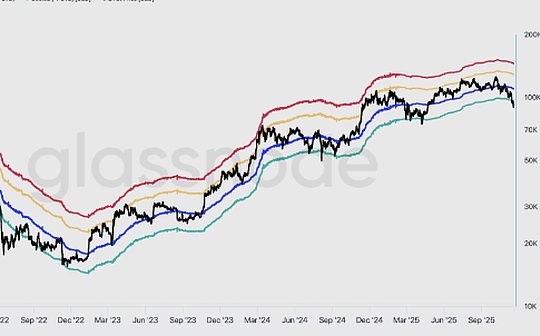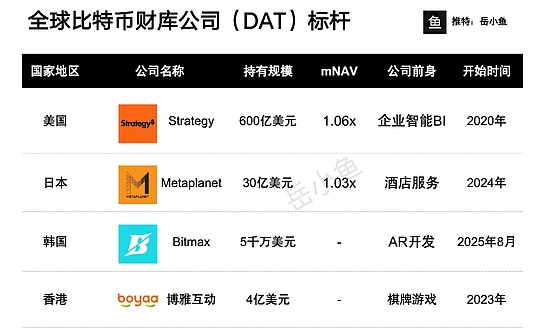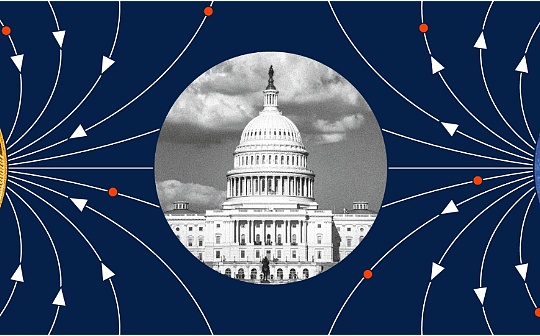
Source: Chainalysis; Compilation: Wuzhu, bitchain vision
As in previous years, North America remains the world’s largest cryptocurrency market, with on-chain value estimated at $1.3 trillion between July 2023 and June 2024, accounting for about 22.5% of global activity.
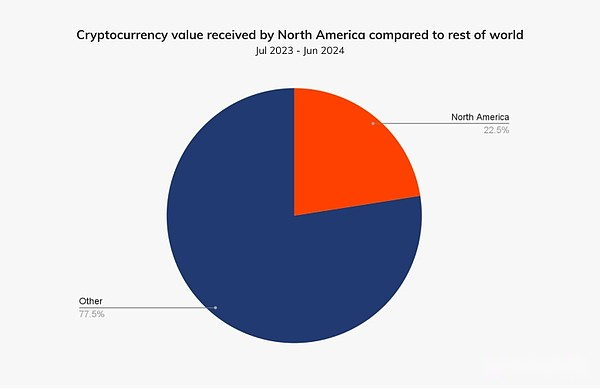
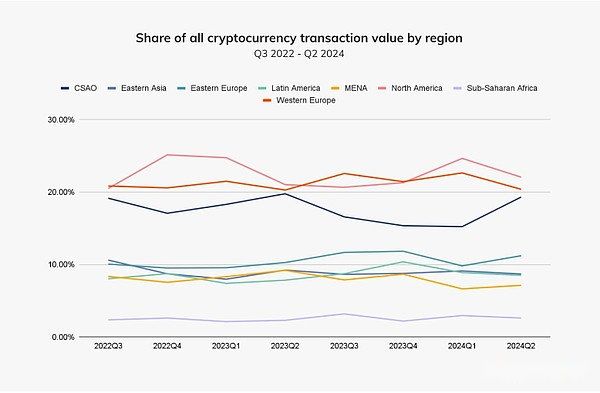
North America’s dominance in the cryptocurrency market is largely driven by institutional activity – more important than any other region.About 70% of cryptocurrency activity in the region involves transfers of more than $1 million, reflecting the growing influence of major financial players in the cryptocurrency market in the region.
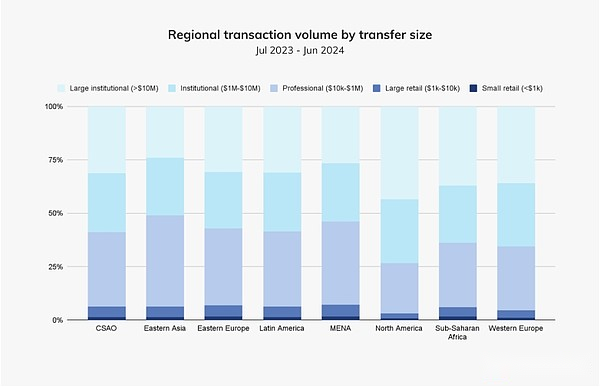
The overwhelming majority of this activity is driven by the U.S., and 2024 proves to be a key year for U.S. cryptocurrency adoption and industry growth.
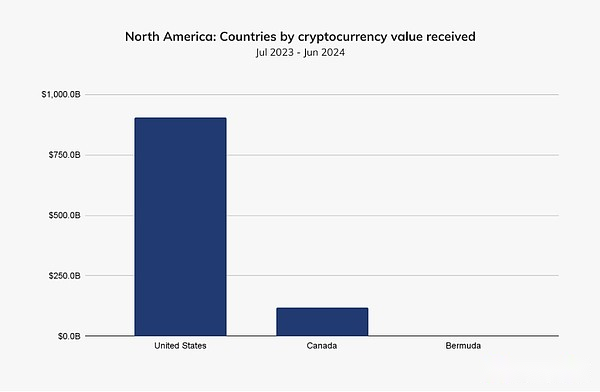
The North American cryptocurrency industry has seen a significant recovery after a bear market that was partially stimulated by the FTX crash in late 2022 and a partially stimulated by Silicon Valley bank failure in March 2023.In March 2024, Bitcoin (BTC) broke through $73,000, a record high, marking a recovery in a period of continuous volatility, ultimately enhancing the integrity and resilience of the ecosystem.
In 2024, the convergence of traditional finance (TradFi) and cryptocurrencies has been consolidated, and the launch of spot Bitcoin exchange-traded products (ETPs) in the U.S. market has strengthened institutional enthusiasm.Exchange-traded funds (ETFs) in particular—the most popular and well-known type of ETP—have attracted the attention of retail and institutional investors.
North America’s cryptocurrency environment is more substantial than ever.Old-established financial entities such as Goldman Sachs, Fidelity and BlackRock have influenced the financial markets in the United States and around the world for decades and are now occupying an important position in the cryptocurrency field.As cryptocurrencies increasingly integrate into the mainstream, this marks a key maturity point in the industry.
The United States is the most important pillar of global cryptocurrency adoption
The US cryptocurrency market is the largest and most influential in the world, and is far ahead of the world.
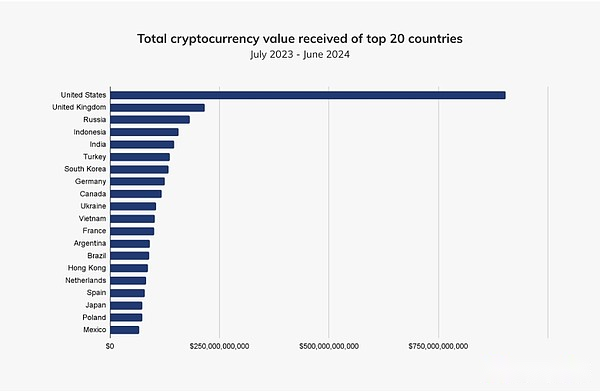
This prominent position is largely due to the country’s huge wealth, huge population, deep and liquid capital markets and a booming innovation ecosystem.The United States also benefits from political stability, favorable investment environment and its current position as the main reserve currency of the international financial system.Supported by these factors, the United States is leading the world in cryptocurrency adoption, ranking fourth in our annual global adoption index.
In terms of growth, the volatility in the U.S. market is significantly higher than that in the global market.In recent quarters, the United States has shown a high degree of sensitivity to both bull and bear markets.When cryptocurrency prices rise, the U.S. market grows more than the global market, and when cryptocurrency markets fall, the opposite is true.We can see this trend below, comparing the growth rate of the U.S. and global markets with the rate of return on Bitcoin.
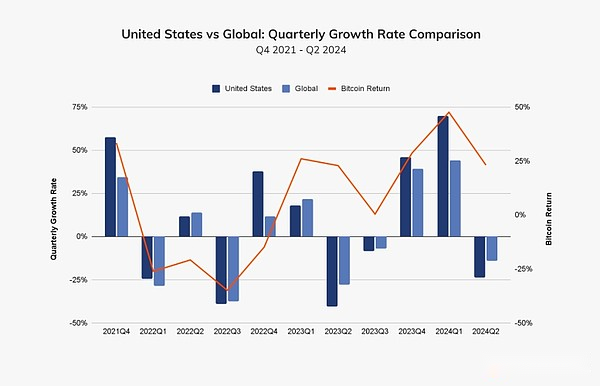
This volatility is largely attributed to the significant level of institutional activity within the country, a trend that makes the U.S. market a key driver of global financial trends such as cryptocurrencies and TradFi.
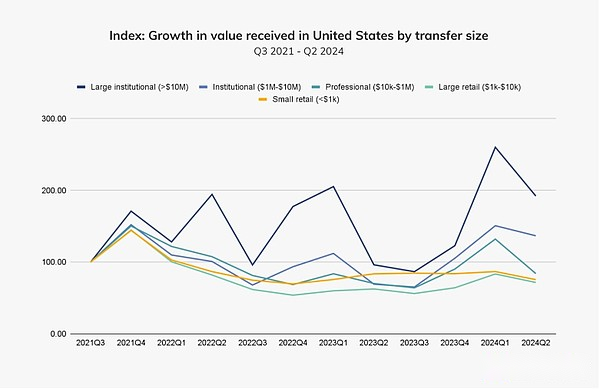
Meanwhile, the United States is becoming a global primary user of centralized services in the cryptocurrency sector, reflecting an increasing reliance on centralized finance (CeFi) platforms such as Coinbase and Gemini for custody and asset management.
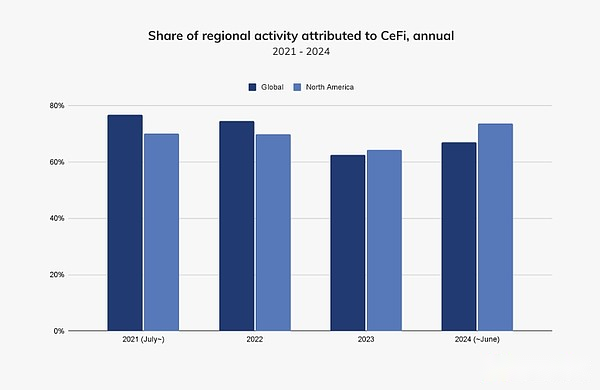
The growing demand for crypto-related financial products such as ETP (which we will explore in more detail below) may drive demand for CeFi.
Gemini, the head of the centralized exchange agency and custodian, emphasized the importance of giving daily users access to digital assets through a centralized platform.“At Gemini, we are in the business of abstraction – our job is to simplify crypto-native technology so that anyone with a phone can safely access digital assets,” she explains.
also,The entry of institutional giants such as BlackRock into the cryptocurrency space highlights the growing convergence of TradFi and cryptocurrencies.To gain insight into this development, we interviewed Kevin Tang of BlackRock Digital Assets team.BlackRock’s entry into digital assets was carefully planned – including BTC and ETH ETP and tokenization – and the strategic CeFi partnership set the stage for its success.For example, in 2022, BlackRock partnered with Coinbase to integrate Coinbase Prime features into the company’s proprietary investment management platform, Aladdin.This integration allows BlackRock and its clients to seamlessly manage Bitcoin and Ethereum risks with traditional assets.“Platform integration is crucial to building the underlying functionality and ultimately paves the way for the construction of IBIT [iShares Bitcoin Trust],” Tang explained.
Centralized platforms may still play a key role in driving the ongoing TradFi-cryptocurrency convergence.“CeFi and centralized institutions are crucial to driving infrastructure development and delivery, enabling companies like BlackRock to operate in the [crypto] space,” Tang stressed.
US market drives global prices as ETP consolidates cryptocurrencies’ links with TradFi
As we explored in other global cryptocurrency markets, the launch of Bitcoin ETP in the United States in January 2024 has had a transformative impact on the U.S. and global cryptocurrency markets, driving institutional interest and bringing unprecedented funding to BTCInflow.
The market immediately experienced a global price bull market after the SEC approval and brought huge positive returns just a few weeks after its launch.
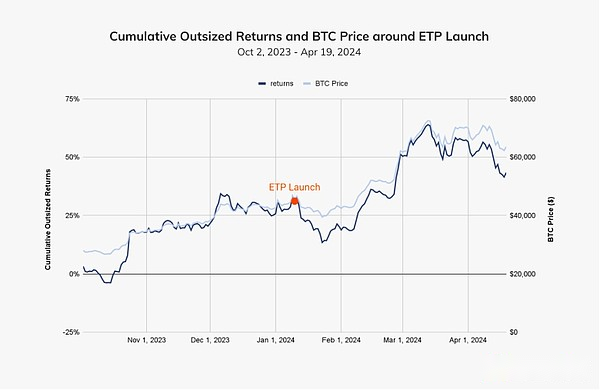
While it is impossible to completely isolate the impact of the U.S. Bitcoin ETP launch, it is widely believed that ETP helps bullish market sentiment and increases institutional BTC exposure.This wave of demand is attributed to the ability of ETP to meet both retail and institutional investors, providing a familiar, regulated tool to gain BTC exposure while avoiding the complexity of managing private wallets or using crypto-native infrastructure.sex.
The launch of Bitcoin ETP in the United States and the Ethereum Spot ETP in a few months later marked a critical moment in the integration of TradFi with cryptocurrencies, mainly because it impacts institutional interests and broader market sentiment.The cryptocurrency market has experienced significant gains as Bitcoin ETP is approved in the United States.

To gain a deeper understanding of the impact of this milestone, we asked BlackRock’s Kevin Tang, whose iShares Bitcoin Trust (IBIT) has become the most popular BTC ETP to discuss its impact.“The launch of the US Bitcoin ETP is historically significant, and it illustrates the suppressed demand for low-cost, efficient and secure Bitcoin investment methods.” IBIT has broken several records, including becoming the fastest ETP to reach $10 billionand the record of assets under management (AUM) reaching US$20 billion.“We have high expectations for asset collection through Bitcoin ETP, and the strong customer interest we have seen so far represents the victory of ETF packers,” Tang said.
Inflows of U.S. Bitcoin ETFs even far outpaced the most popular gold ETFs in history in the first 200 days of launch, making it the most popular ETP category in history.

This rapid adoption confirms strong potential demand for regulated, institutional-level products that provide BTC access.
The impact of US Bitcoin ETP is not only the US phenomenon, it also has far-reaching impacts and also lays the foundation for a wider wave of international adoption.Tang pointed out that the product attracted investment from Asia, Europe and Latin America.“The global impact of these ETPs is undeniable.”Tang further emphasized thatBitcoin is increasingly seen as a unique diversification tool for global currency alternatives and investment portfolios, especially as a potential hedge against inflation or geopolitical instability – BlackRock’s recent comment on Bitcoin for investorsThe white paper of unique value propositions also echoes this.
The growing acceptance of BTC and ETH as assets worthy of serious investment has paved the way for wider institutional adoption.Tang pointed out that many investors are now having a more in-depth discussion on the role of BTC and other crypto assets in their portfolios.“They are asking how Bitcoin can fit into the portfolio with other traditional investments,” he said, noting that the launch of ETP has opened the door to wider access to cryptocurrencies.“ETP has shifted the topic to the investment advantages and value propositions of BTC and ETH, not just the logistical challenges of how to acquire them,” Tang explained.
For many institutions, Bitcoin ETP is the first step in deep participation in the cryptocurrency market.This risk may ultimately lead to broader investment in blockchain technology and decentralized finance (DeFi), far beyond the risk of BTC and ETH prices.“Currently, we focus on BTC and ETH because we see the clarity of demand and regulation,” he explained.“As the market grows, we are always committed to meeting the needs of our customers.”
Through continuous efforts to educate investors and build trust in the field, traditional financial institutions such as BlackRock play an important role in reshaping the way institutions handle cryptocurrencies, laying the foundation for broader adoption in the future.As Tang said, “We firmly believe that blockchain technology, especially the potential of tokenization, has the potential to disrupt traditional finance.”
US market stablecoin growth stagnates
Despite record activity, the U.S. market has also faced some challenges over the past year, including a significant deviation from U.S. regulatory platforms.This trend may reflect the obstacles brought about by slow regulation of stablecoins and digital assets.
As of 2023, the share of stablecoin trading on U.S. regulators has been growing steadily, consistent with the increase in global stablecoin adoption.However, by 2024, this trend began to reverse, as shown below.
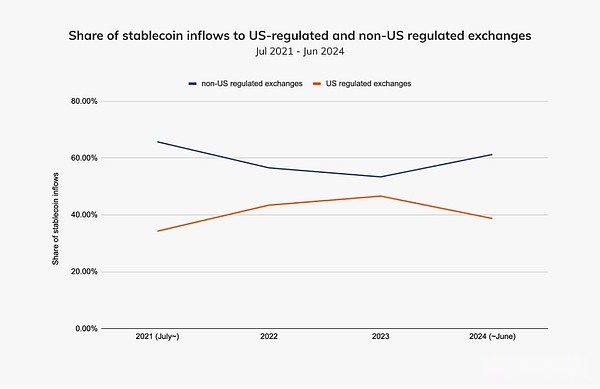
Given the surge in stablecoin adoption in emerging and global markets, this shift may reflect a relative rather than absolute decline in stablecoin use in the U.S. market.Now, more and more stablecoin transactions occur on exchanges that are not regulated by the United States, indicating that global stablecoin adoption is exceeding the growth rate in the United States.Below, we can see both the US-regulated and the non-US-regulated.Regulated exchanges are growing, but stablecoin activity in non-U.S. exchange markets are growing faster.

As mentioned above, this shift does not necessarily indicate a sharp decline in US market participation, but rather indicatesThe role of stablecoins in emerging and non-U.S. markets has expanded rapidly.
To further understand the evolving stablecoin market, we interviewed Circle, the issuer of USDC, a stablecoin pegged to the US dollar.Circle stressed that global demand for dollar-backed assets is growing, especially those outside the traditional banking system, because their chances of access to stable currencies are limited.
“One way to consider the near-term opportunities of the USDC is to focus on global demand for fiat dollar cash,” a Circle spokesman explained. “The Federal Reserve estimates that nearly $1 trillion in U.S. banknotes (45% of all bills in circulation) are stored,” he said.Outside the U.S., two-thirds of the $100 bills are circulating abroad. This demand remains despite difficulties for people outside the U.S. trying to obtain dollars through local banking systems.”
The growth in stablecoins use outside the United States reflects a broader trend that international markets facing currency volatility are turning to USD-denominated stablecoins to preserve value and facilitate faster and cheaper transactions.Stablecoins such as USDC and USDT (Tether) provide a compelling solution to gain stability in the U.S. dollar without using traditional banking channels, which are often harder to obtain outside the United States.
despite this,Uncertainty in U.S. regulation is threatening the country’s leadership in the stablecoin field.Circle pointed out that due to the lack of clear regulatory rules in the United States, other financial centers such as the European Union (EU), the United Arab Emirates (UAE), Singapore and Hong Kong can attract stablecoin projects with a more favorable regulatory framework.The spokesperson pointed out: “Europe has successfully achieved the unachievable goal of the United States through the MiCA framework: to provide legal and regulatory clarity for the entire digital asset market.” The Crypto Asset Market Supervision (MiCA) began to take effect in June 2024,EU stablecoins laid the regulatory foundation.
Regulatory clarity outside the United States is driving global stablecoins growth, while the United States is at risk of lagging behind.”The lack of a regulatory framework for US dollar stablecoins, which poses a threat to U.S. interests,” a Circle spokesman warned. “This vacuum has stimulated growth in stablecoins outside the United States, as demand for the U.S. dollar is greater in these regions.”The opportunity cost of the United States is not just about missing out on economic activity related to stablecoins, it also faces the risk of losing its influence and authority over the future role of the US dollar in on-chain commerce.This is no different from the historical precedent of the EuroDollar, which initially received little attention from U.S. policy makers due to its small market size.However, the Euro dollar grew rapidly and helped consolidate its international status – a lucky one for lawmakers.If the U.S. continues to lag behind in providing transparency, this may not be the case with stablecoins.
Nevertheless, despite regulatory delays, Circle remains optimistic about USDC’s potential in the United States.They added: “The United States is the home of the dollar and the home market for Circle, and we are optimistic about the potential of USDC here.” However, as more countries develop regulatory frameworks that encourage the adoption of stablecoins, especially in inflation, are being added.And regions where unstable stimulate demand, U.S. policymakers face increasing pressure to take action.”A key question now is whether the United States will eventually formulate its own stablecoin rules or maintain an uncertain status quo, which policymakers in both parties say is unacceptable,” they said.
The United States has not made no progress in stablecoins.Circle mentioned the stablecoin bill proposed by the House Financial Services Committee in July 2023, which could provide the regulatory clarity needed for the U.S. market to remain competitive.“Congress should ratify the bill on a bipartisan basis,” they urged. Establishing clear anti-money laundering/fighting terrorism financing and sanctions obligations for stablecoin issuers is crucial to ensure that the U.S. stablecoin maintains its global reach..
Canadian market follows the United States
Although the Canadian market is smaller than the U.S. market, it remains a major player in the North American market, creating approximately $119 billion in value between July 2023 and June 2024.
Although the Canadian market follows the U.S. trend, volatility is often smaller, with the rise in bull markets being more moderate and the decline in bear markets being more moderate.

Canada is closely related to the global average in terms of asset distribution and transaction size.
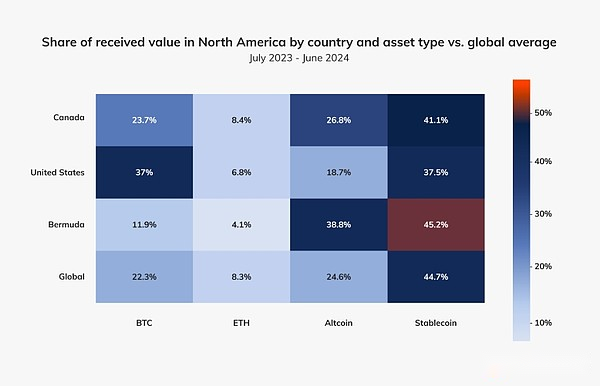
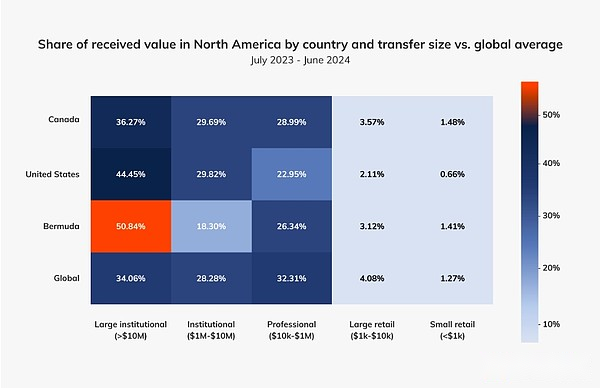
To understand the reality of the cryptocurrency landscape in Canada, we interviewed Kunal Bhasin, Partner and Co-Head of Consulting Services, KPMG Center for Excellence in Digital Assets.Bhasin provides insights on Canadian cryptocurrency adoption and some of the challenges facing the industry.
Several major cryptocurrency companies in Canada suspended operations in the country after regulatory reforms implemented last year (with stricter rules on custody, leverage and stablecoins), and Gemini joined Binance and OKX as the latestExit the exchange.However, Bhasin said that this trend is not just due to regulatory challenges.”Canadian regulators have provided cryptocurrency exchanges with clearer transparency than other North American jurisdictions by introducing the concept of crypto contracts, which clarifies the applicability of securities regulations to crypto platforms,” he explained. He believes that theseThe exit of the exchange may have arisen from broader business decisions rather than an infeasible framework.Nevertheless, Bhasin stressed that Canadians still have “many regulated places to participate in cryptocurrencies in meaningful ways.”
While Canada’s regulatory framework for trading platforms and investment funds helps maintain some confidence, the gap remains – especially in the regulation of stablecoins and DeFi.“Canada’s approach to regulatory stability coins is somewhat different from those taken by other forward-looking jurisdictions such as the EU, the UAE, Hong Kong and Singapore,” Bhasin explained.”There is no clear regulatory framework for stablecoins. So you may see stablecoin issuers leave Canada and related cryptocurrency innovations are also shifting outside of Canada.”
Despite these obstacles, Bhasin talked about promising development.The Canadian Investment Regulatory Organization (CIRO) is a pan-Canada self-regulatory organization that currently supervises all investment traders, mutual fund traders and trading activities in the Canadian debt and stock markets.Under this framework, cryptocurrency exchanges must become members of the CIRO, thus subjecting them to stricter disclosure, internal controls and regulatory reporting requirements.”This is a sign of the growing maturity of the regulatory environment for Canadian cryptocurrency companies,” Basin said.
Another challenge to Canada’s adoption of cryptocurrencies is the reluctance of major financial institutions to participate meaningfully in cryptocurrencies.“Big banks around the world have taken appropriate measures to understand the unique risks of cryptocurrency companies regulated by the banking industry and incorporated enhanced due diligence programs related to cryptocurrency operations, which are the new source of deposits for these banks. However, weThere are no similar measures seen in Canada’s banks,” Bhasin explained.“This makes it difficult for cryptocurrency companies to access banking services, resulting in some innovations moving outside of Canada.” In addition, he noted that large Canadian banks have cryptocurrency teams and have conducted various pilot programs and proof of concepts, however, “when needed, “there is no need for a cryptocurrency market.”Leadership tends to back down when going beyond these pilots,” he said, attributeing it to risk aversion and tendency to maintain existing business models rather than undermining them through new, potentially risky crypto businesses.
An important driving factor in global adoption of cryptocurrencies is the positive position of governments, such as Singapore and the UAE, which use cryptocurrencies as part of their economic strategies.Bhasin said that strengthening government participation can stimulate growth and investment.“More involvement is needed at the federal level to make digital assets a priority in Canada,” he said.
Despite the challenges facing Canada’s cryptocurrency market, Bhasin is optimistic about the future, especially given the ongoing efforts of the public and private sectors.“Canada still has a strong regulatory environment for certain cryptocurrency activities such as investment funds,” Bhasin said, noting that Canada is the first country to launch a pledged ETH ETF.“It is possible to further develop this by providing a clear roadmap for the primary and secondary markets of tokenized real-world assets,” he added. “If the government prioritizes cryptocurrencies and we continue in the regulatory field.Progress is made, then there is no reason Canada cannot take the position of global leader in cryptocurrency adoption.”
The future development of North American cryptocurrencies depends on the balance between institutional momentum, regularity clarity and innovation
The huge influence of North America, especially the United States, on the global cryptocurrency market is undeniable.Driven by the introduction of ETP and the continuous development of TradFi-cryptocurrency convergence, the region’s dominance during this period has greatly shaped the domestic and international cryptocurrency landscape.As Gemini’s Claire Ching pointed out, “Institutional adoption takes on a different style in this cycle. After the amazing decline of FTX in the last cycle, it became more cautious and required more diligence. With this level ofWith attention and resources, the organization’s commitment to the field is firmly consolidated.”
Institutional giants like BlackRock are no longer just experimenting – they have made full investments, which shows that cryptocurrencies have moved from the edge to mainstream financial conversations.Speaking about this paradigm shift, BlackRock’s Kevin Tang expressed the importance of “the ongoing view of blockchain as a transformative technology, which has the potential to disrupt traditional paradigms and value chains – not only in the financial sector,And across industries and sectors a wider range.”
Despite the strong momentum, the challenge remains.Regulatory uncertainty in the United States and Canada, coupled with the shift in stablecoins market share outside North America, emphasizes the need for balanced innovation, clear regulatory frameworks and ongoing institutional support to ensure sustained growth and stability across the crypto industry.


